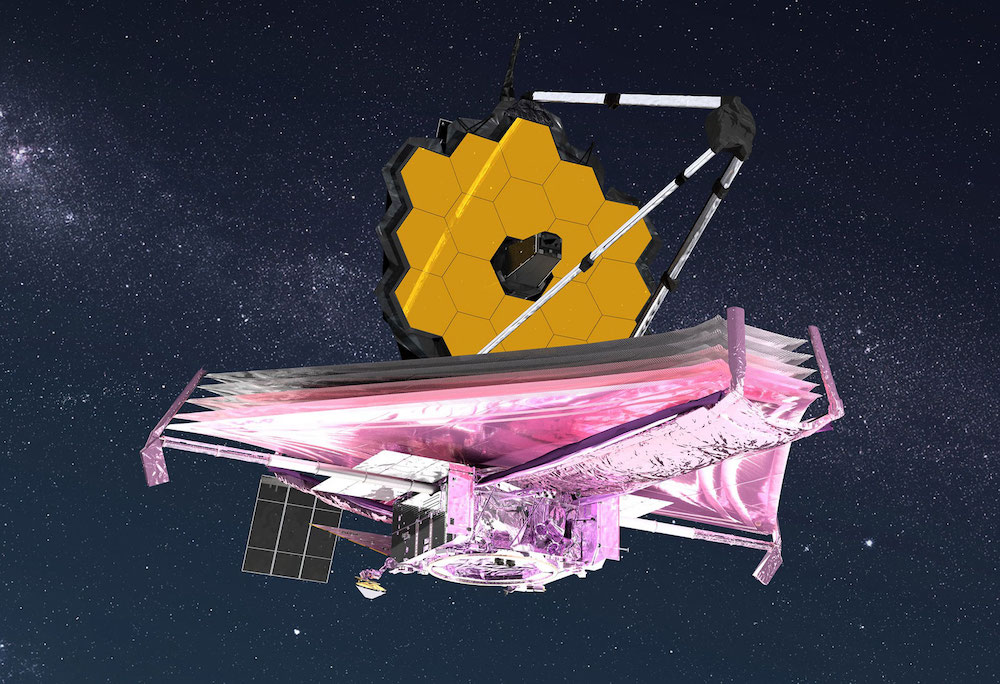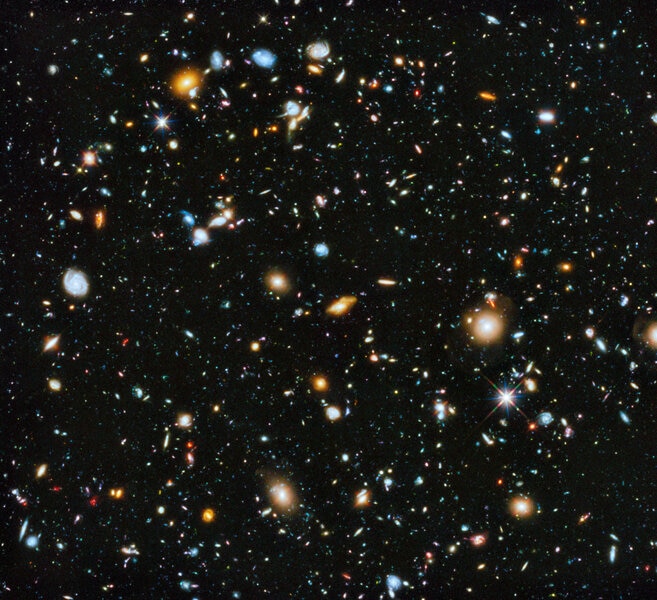Create a free profile to get unlimited access to exclusive videos, sweepstakes, and more!
James Webb Space Telescope is now fully deployed! But there's still a long way to go.
The major components have unfolded and are ready to be tested.

Now witness the observational power of this fully deployed and not-quite-yet operational space telescope.
— Emperor Palpatine, kinda
On Saturday morning, January 8, 2022, the eyes of James Webb Space Telescope became fully opened, and the massive observatory now ready to begin its long testing phase to focus its individual 18 hexagonal mirror segments into a single, monolithic vision of the Universe.
This is an incredible achievement. JWST is a ridiculously complex observatory just due to its capabilities. But a whole other dimension of complexity had to be added due to its size.
JWST launched on board an ESA Ariane 5 rocket on Christmas Day, December 25th, but it wasn't that simple. Several major components of the observatory were far too large to fit inside the Ariane 5 rocket's payload fairing, so the telescope was designed to fold up for launch, and unfold like a flower during its month-long cruise to its destination in space — the Lagrange 2, or L2, point, a stable region of space about 1.5 million kilometers from Earth where gravitational and centrifugal forces between our planet and Sun balance.
The first of these components is the giant sunshield, a five-layered parasol that cools the telescope by reflecting sunlight away from it. JWST observes in the far infrared, where warm cosmic objects emit light. The telescope itself has to be cooled to a chilly -235° C, or about -400°, lest its thermal glow interfere with its own observations! So it sits in the shadow of the sunshield and passively cools, radiating its heat into space.
The sunshield is about the size of a tennis court. Folding and unfolding it like a 300-square-meter example of origami is extremely difficult, and was tested thoroughly on the ground. But space is a harsh and the environment difficult, so everyone on the teams was extremely nervous during its deployment days after launch. Happily, each layer unfolded and extended successfully.
The second big component was the primary mirror itself. Like most telescopes you can buy for your own use, it has a primary mirror that collects light from the cosmos like a bucket collects rain in a storm. The primary mirror reflects that light to a secondary, smaller mirror in front of it, which then reflects that light through a hole in the primary. A third mirror corrects the focus and shape of the incoming light before sending it on to the scientific cameras.
The secondary mirror, about 0.75 meters across, is attached at the end of a seven-meter-long three-legged boom that was mounted behind the primary mirror. That successfully deployed on January 5th.
The primary mirror — the telescope's main eye — consists of 18 smaller hexagons, each about 1.3 meters across. Again, this was far too large to fit in the rocket fairing, so the mirror was designed to fold up. There's a central column of 12 hexagons, and two foldable “wings” on either side with 3 hexagons each. The wings were rotated behind the main column for launch.
On Friday, January 7th the port side wing was deployed — the one on the right as you face the mirror. Over several minutes the motors slowly moved it into position next to the central column, then a complex series of latches were used to secure it into place.
The starboard wing was deployed the next day, on Saturday January 8. And once the latches were clicked home, the James Webb Space Telescope was confirmed to be fully deployed.
Amazing.
Here's an animation of the whole sequence:
But we're not done yet. While the 18 hexagonal mirrors are now in place, they aren't perfectly aligned — like when you put new tires on a car, they can be mounted in place but still need to be adjusted and balanced.
So the next step is to very carefully align the 18 hexagonal mirror segments to act as one giant mirror. JWST will point to a bright star, and each mirror will reflect an image of that star. Each mirror has seven actuators on its backside, small motors with extremely fine control, that can tip and tilt the mirror until it is placed as accurately as possible. That placement is indeed incredibly accurate; the motors can move the mirrors in steps of roughly 1/100th of a micron — for comparison, a human hair is 100 microns wide, 10,000 times larger!
So the engineers on Earth need to figure out which star image they see is from which mirror, then adjust each of the 18 mirrors until the images are as sharp as possible and aligned in the same spot.
Once done, JWST will have what is essentially a 6.5-meter-wide mirror ready to observe. There are two advantages to such a large mirror. One is that, as a light bucket, the bigger it is the more light it collects, and the fainter an object it can see. JWST's mirror is more than 2.5 times wider than Hubble's mirror, and will collect over 7 times as much light.
Also, the bigger the mirror the finer the detail it can see. Basically, the bigger the 'scope the better it can differentiate between sources of light that are very close together. This also depends on the wavelength of light observed — Hubble can detect ultraviolet, visible, and near-infrared light, but JWST looks out in longer infrared wavelengths. This means its resolution will be similar to Hubble's, but can see at wavelengths Hubble cannot.
And that's the true power of JWST. IR light comes from objects all over the Universe, from nearby asteroids to more distance solar system planets and icy Kuiper Belt Objects, to warm dust around other stars and exoplanets to brown dwarfs and distant galaxies. In fact, due to the expansion of the Universe, very distant galaxies have their light redshifted to the infrared, meaning JWST will see more distant galaxies even than Hubble, giving us insight into how the cosmic structure we see today first got its start.
Still, first things first. The hexagonal mirror alignment began on Sunday, January 9th, and will continue possibly for several months. On January 23rd the last course correction will occur, and a few hours later the James Webb Space Telescope will reach its new home.
But even then it won't start science operations! It will take five more months of shakedown and testing to make sure the mirrors all work well, the scientific cameras are healthy and adjusted to be picture perfect, and all the other systems on this immensely complex and finely crafted machine all sing together in unison.
So stay tuned. A lot of the most nerve-wracking fingernail-biting parts of this mission are now behind us, but plenty still to get through before JWST starts returning jaw-dropping images of the Universe to Earth.
You can keep up with the progress reading the What's Up With Webb blog, co-written by my old friend and astronomer Heidi Hammel, and following the JWST feeds on Twitter by NASA and ESA.



























